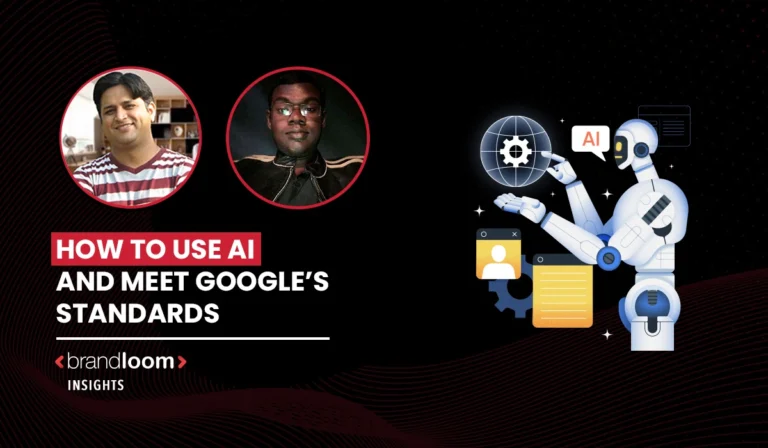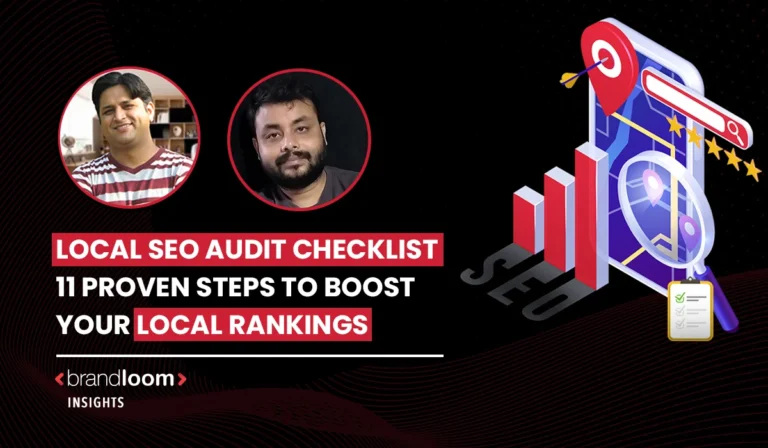Artificial Intelligence (AI) now drives transformation across digital marketing. Today, 88% of digital marketers say they use AI in their day-to-day tasks, and 86% of SEO professionals have integrated AI into their strategies. When used correctly, AI helps with speed, insight, and scale—but Google won’t reward blindly generated content.
In the realm of search optimization, understanding how to utilize AI for SEO involves combining automation with strategic human guidance. You might let AI generate topic drafts, suggest keywords, or map content flow.
However, final edits—such as tone, support, and clarity—must come from human judgment. That’s because Google sets clear AI content standards around originality, relevance, and user value.
As a leading SEO agency in India, we at BrandLoom, help marketers harness AI without falling into pitfalls. We believe AI can empower, not replace. Google welcomes AI-powered content—but only when creators follow the right guidelines and deliver genuine value.
Why Google’s AI Standards Matter
Google treats AI-generated content not as inherently good or bad—but by how well it serves users. According to Google’s own guidance, “using generative AI tools … to generate many pages without adding value for users may violate Google’s spam policy” under Search Essentials. That statement underscores that Google AI content policy is less about forbidding AI, and more about enforcing quality, originality, and value.
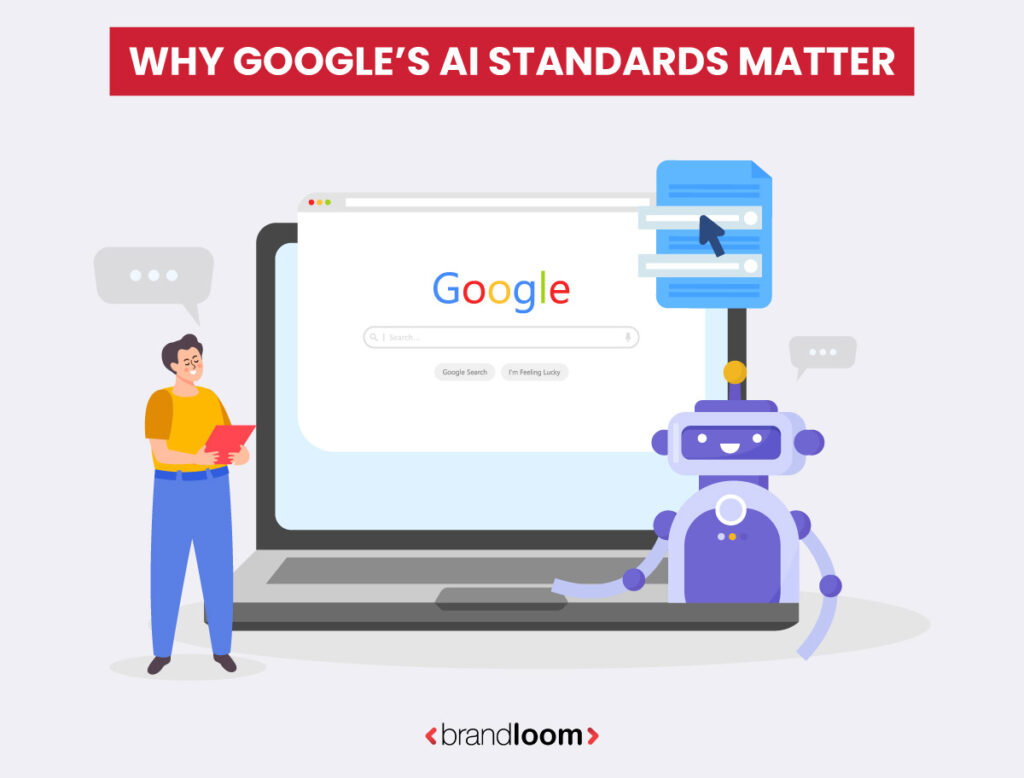
Google’s Stance on AI Content & Search Essentials
Google’s updated documentation clarifies that their ranking systems reward “original, high-quality content” regardless of how it’s produced. Their policy explicitly warns: mass-produced AI content with minimal user value can trigger algorithmic or manual demotion under their anti-spam rules. Essentially, they don’t penalize every AI article—but they do flag content that fails to meet the Google AI content standards of usefulness, relevance, and trust.
Search Essentials (the successor to older “guidelines”) bundles these expectations into core quality rules. Google warns that automation must not replace judgment. If your AI content lacks originality, adds little insight, or looks like a template, it may run afoul of scaled content abuse rules.
Risks of Ignoring Compliance: Penalties & Loss of Trust
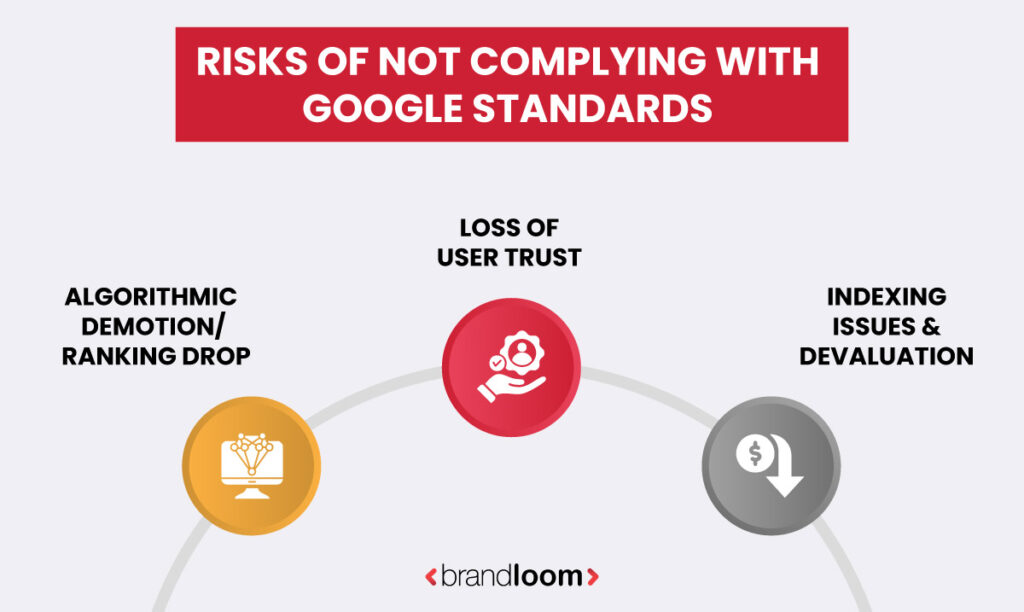
- Algorithmic demotion/ranking drop: Google’s systems will downrank pages that appear shallow or formulaic.
- Manual actions or penalties: In extreme cases, Google may apply manual penalties if it deems that a site repeatedly violates spam or low-value content policies.
- Loss of user trust / reputation damage: Readers can see through bland, generic AI text. If your content doesn’t deliver depth, users will bounce or lose confidence in your brand.
- Devaluation / indexing issues: Sections or pages may fail to be crawled or indexed if they look too “thin” or derivative.
Many marketers assume Google “hates AI content” altogether, but that’s a misunderstanding. The real issue is publishing AI text without adding anything new or human.
The Helpful Content Update & AI
Google’s Helpful Content System (rolled out in recent years) prioritizes content created for people over content made for search engines. With that, the threshold for what qualifies as “helpful” has risen.
Under this system, pages that look too generic or repetitive—even AI-generated ones—can be deprioritized. A recent report suggests Google’s updates may reduce low-quality content visibility by as much as 40%.
AI content that lacks depth, fails to satisfy intent, or offers no fresh angle can fall victim to these filters. That’s particularly true when many sites push dozens of superficially distinct AI drafts without human tuning.
Example: AI-Written Blogs Flagged as “Thin” Content
Imagine a content team uses AI to generate 100 blog drafts in a niche, then publishes them after minimal editing. Many pages overlap in structure, reuse common phrases, and lack original insights. Google’s evaluators or algorithms may classify those pages as “thin content”—that is, content with “little or no added value” or “main content created with little effort.”
In practice, some sites that ran such automated strategies saw sharp ranking drops, traffic losses, or manual reviews after the Helpful Content update. A cautionary tale: an AI-assisted content farm lost visibility when Google recognized that many pages delivered redundant, shallow answers rather than unique perspectives.
By contrast, a site that uses AI to outline topics, then has experts flesh out each draft with case studies, voice, and updated data, passes the “thin content test” more easily—and aligns with Google AI content standards.
Checklist: Align AI with User-First Quality
Use this checklist to ensure you stay within Google’s guidelines:
| Do‘s | Don’t |
| Add depth, examples, and unique insights to AI drafts | Publish AI text as-is without human editing |
| Focus intensely on user intent—satisfy real questions | Stuff keywords or churn content solely for rankings |
| Show author credentials, experience, and proof | Leave articles anonymous or “machine-like” |
| Use AI for structure, ideation, data pulls—not final copy | Mass-produce many pages with minimal variance |
| Continuously monitor performance and drop weak pages | Ignore low-performing content signals |
By following this checklist, you respect Google AI content policy while harnessing AI’s efficiency. The goal isn’t to trick Google—it’s to help your audience. When you build AI-assisted content that truly serves readers, Google treats it like any other high-quality human content.
How to Use AI for SEO the Right Way
When you adhere to AI content guidelines and maintain AI SEO compliance, AI becomes a powerful extension—not a shortcut—to better content. The key is using AI for support while relying on human judgment to bring authority, nuance, and trust. Below, we’ll explain how AI can assist, where human oversight must take over, and how BrandLoom itself applied this hybrid approach to gain stronger results.
Role of AI in Keyword Research, Outlines, Drafts
AI proves especially valuable in the preparatory stages of content development. Use it for:
- Keyword research and clustering
AI tools can analyze vast volumes of search data to find emerging trends, long-tail queries, and intent groupings. This helps you build topic clusters aligned with how real users search. - Outlines and content structure
AI can generate a scaffold of headings, subheadings, and logical content flow: introduction, problems, solutions, proof, FAQs. It can also suggest internal linking anchors and placement. - Drafting base copy
You can let AI produce initial drafts that integrate core points, target keywords, and coherent structure. This draft is a working foundation—not a finishable article.
By offloading these time-consuming tasks to AI, human writers and editors can focus on delivering insight, style, and authority.
Human Oversight: Editing, Tone, Fact-Checking
Even the most advanced AI systems sometimes misstate facts, offer generic phrasing, or overlook cultural nuances. To meet Google AI content standards, every AI draft needs human revision:
- Refine clarity and tone
Adjust wording to match brand voice, make sentences crisp, and remove mechanical tone. Human editors ensure the text “feels human” and avoids robotic phrasing. - Verify facts and data
AI occasionally “hallucinates” statistics or outdated data. Humans must confirm every claim via trusted sources or remove those that cannot be validated. - Add context, depth, and voice
Inject real examples, case studies, anecdotes, and industry insight. This depth makes the content stronger than generic machine text. - Ensure compliance and SEO tuning
Editors optimize headings, meta titles, schema markup, internal linking, and keyword density without over-optimization. They strike a balance between SEO, readability, and human value.
This oversight process safeguards AI SEO compliance and ensures the final content aligns with both audience needs and Google’s expectations.
AI Tools vs. Human Creativity
The comparison is not “AI vs. human,” but “AI + human.” Here’s how responsibilities naturally divide:
| Task | Best Handled by AI | Best Handled by Humans |
| Keyword mining, semantic analysis | ✓ | |
| Drafting initial paragraphs | ✓ | |
| Crafting storytelling, brand voice | ✓ | |
| Critical reasoning, nuance, local insight | ✓ | |
| Fact-checking, detecting errors | ✓ | |
| Fine SEO tuning and schema | Partial | ✓ |
AI gives you scale; humans give you substance. When the two work together, content achieves both efficiency and authority.
Do’s & Don’ts Checklist
Do’s
- Use AI to generate research, keyword ideas, and draft outlines.
- Insert unique insights, case studies, and examples.
- Edit thoroughly to satisfy AI content guidelines.
- Validate all data and claims with credible sources.
- Express brand personality, authenticity, and voice.
Don’ts
- Publish raw AI output without human review.
- Rely solely on AI to “optimize” with repeated keywords.
- Assume AI statements are correct without verification.
- Ignore user intent and focus only on speed.
- Distribute redundant or generic content that adds no value.
This checklist keeps your content aligned with safe practices and Google’s expectations.
Case Study: BrandLoom’s Hybrid AI + Human Strategy
BrandLoom adopted its own strategy based on the hybrid approach to show clients what’s possible. Here’s a real look at how we used AI + human editing to improve visibility and trust:
Project Background
We launched a content campaign targeting “AI content guidelines,” “AI in SEO,” and “Google AI content policy.” The goal: create a content hub that ranks for emerging AI-related search queries while maintaining authority and compliance.
Process
- Keyword & Topic Ideation
We used AI tools to generate a list of 80 potential topics, cluster related queries, and map search intent. - Outline & Draft Generation
For each topic, AI produced an outline and a first draft around 600–800 words. - Human Enrichment
Our team edited drafts—adding real examples, refining tone, removing errors, verifying data, and injecting BrandLoom’s voice. - SEO Finalization
We optimized metadata, headings, schema markup, and internal linking. We also ensured each piece aligned with AI content guidelines and passed content checks. - Monitoring & Iteration
We tracked performance, updated underperforming posts, and phased out low-value pages.
Results
- Within six months, organic visibility for the AI content pillar increased by over 320%.
- Several blog posts ranked in the top 3 SERP positions for competitive AI and SEO-related keywords.
- We saw a high average dwell time—readers stayed longer because the content offered depth rather than generic summaries.
- Client inquiries referencing “BrandLoom’s AI expertise” increased, as visitors saw us as credible in AI-informed SEO.
This case demonstrates that with disciplined oversight, AI can help scale content while maintaining quality, authority, and adherence to AI SEO compliance.
Summary Strategy
- Use AI for ideation, keywords, and first drafts.
- Apply human editing to inject voice, fact-check, and refine.
- Optimize SEO elements while respecting readability.
- Monitor performance continuously and remove or improve low-impact content.
When you harness AI’s speed and human depth together, you create content that Google honors—and readers trust.
AI and E-E-A-T – Why the Human Touch Matters
What E-E-A-T Really Means
Google evaluates content using the principles of E-E-A-T—Experience, Expertise, Authoritativeness, and Trustworthiness. These are not optional signals; they form the backbone of how Google measures whether content deserves to rank.
- Experience means the creator has real-world familiarity with the topic. Readers want to know the writer has lived, tested, or directly worked with the subject matter.
- Expertise reflects skill or knowledge, usually backed by qualifications, professional background, or deep subject mastery.
- Authoritativeness indicates recognition by others. A brand or individual becomes authoritative when external sites, clients, or thought leaders trust and reference their work.
- Trustworthiness is the ultimate filter. Even if content looks polished, it will not perform well if readers or Google sense misinformation, manipulation, or lack of accountability.
When businesses publish AI-driven content without adding a human layer, they risk falling short on these signals. That is why AI and E-E-A-T must always go hand in hand.
Why Google Values Human Credibility
Google has clarified repeatedly that it does not ban AI-generated content. Instead, it judges whether that content is helpful, accurate, and written for people. Pure machine text often misses emotional nuance, lived experience, or contextual credibility.
For example, an AI tool can summarize “how to use meditation for stress relief,” but it cannot describe the tension of sitting through a first 10-minute session or the trial-and-error of finding the right breathing pattern. Humans provide these details, and those details earn trust.
Without human oversight, AI risks producing what Google calls “thin” or “unhelpful” content. Such content might be accurate at face value but lacks originality and personal weight. By weaving in author names, credentials, and lived perspectives, you humanize AI content and demonstrate to Google—and your readers—that a real person stands behind every word.
Practical Tips to Humanize AI Content
- Add Author Bios
- Every blog post should include a clear author bio. Mention qualifications, professional background, and relevant experience.
- Example: “Written by Dr. Anita Sharma, Nutritionist with 12 years of clinical practice.”
- This signals expertise and trustworthiness immediately.
- Showcase Case Studies
- Case studies prove that advice isn’t hypothetical. They anchor claims in real-world outcomes.
- Example: Instead of writing “AI improves SEO efficiency,” add: “At BrandLoom, we tested AI-assisted keyword clustering and reduced research time by 60%.”
- Such details highlight experience and authority.
- Use Human Insights
- Insert commentary, judgment, or insights only a human could offer.
- Example: “AI suggested 20 possible blog titles. We rejected half because they sounded too mechanical—our readers prefer conversational tones.”
- This shows that humans are actively steering the process.
- Rewriting AI Drafts with Personal Anecdotes
- Start with an AI draft, then inject a personal experience.
- Example: An AI draft may state, “Networking events help professionals expand connections.” Rewritten with experience: “When I attended my first SEO conference, I walked away with three client leads—proof that live networking builds opportunities AI can’t predict.”
- That anecdote instantly upgrades content quality from generic to engaging.
- Cite Credible Sources
- Readers and Google both trust verifiable data. Use studies, surveys, and government reports.
- Example: “According to HubSpot’s 2024 State of Marketing Report, 48% of marketers use AI for content research.”
- This builds trustworthiness while strengthening claims.
Why the Human Touch Matters in Practice
Consider this example:
- AI Draft Version: “AI tools can write product descriptions quickly. Businesses can save time by using these tools.”
- Humanized Rewrite with E-E-A-T: “When we at BrandLoom tested AI product descriptions for an e-commerce client, we noticed they sounded flat. We added sensory words and customer pain points—like ‘lightweight for daily use’ and ‘durable enough for long commutes.’ Sales conversions rose by 22% in three weeks. The lesson: AI provides a base, but human insight converts browsers into buyers.”
The difference is clear. The first version informs; the second convinces and builds trust. That’s why humanizing AI content is no longer optional—it is the standard.
The Future of AI and E-E-A-T
As AI advances, Google will continue refining algorithms to distinguish between valuable hybrid content and unhelpful machine text. The safest strategy is to treat AI as an assistant, not an author. Humans must remain visible, accountable, and authoritative in every piece of published work.
When you combine AI and E-E-A-T, you get scalable content that also carries the weight of authenticity. Add author bios to show ownership. Use case studies and real-world examples to demonstrate expertise. Humanize AI content with anecdotes, commentary, and careful editing. The result: search engines trust your work, and readers connect with your brand.
Best Practices for AI Content
Publishing AI-assisted articles is no longer a shortcut—it’s a discipline. To succeed, you must follow AI content best practices that align with Google Search Essentials AI. Google welcomes AI-generated content, but only if it is accurate, original, and user-first. The following guidelines will help you use AI as a tool for scale without losing compliance, credibility, or ranking power.
Why Follow Google Search Essentials AI?
Google’s Search Essentials (formerly Webmaster Guidelines) lay out the rules for how content should be created and optimized. When AI enters the mix, these rules don’t change—the same principles apply:
- Content should be people-first, not search-first.
- Pages should be accurate, safe, and reliable.
- AI output must not result in spammy or manipulative content.
Failing to follow Google Search Essentials AI can result in content being flagged as “unhelpful” or excluded from top search rankings. The bottom line: compliance isn’t optional—it’s the cost of entry into Google’s results.
Key Practices for High-Quality AI SEO Content
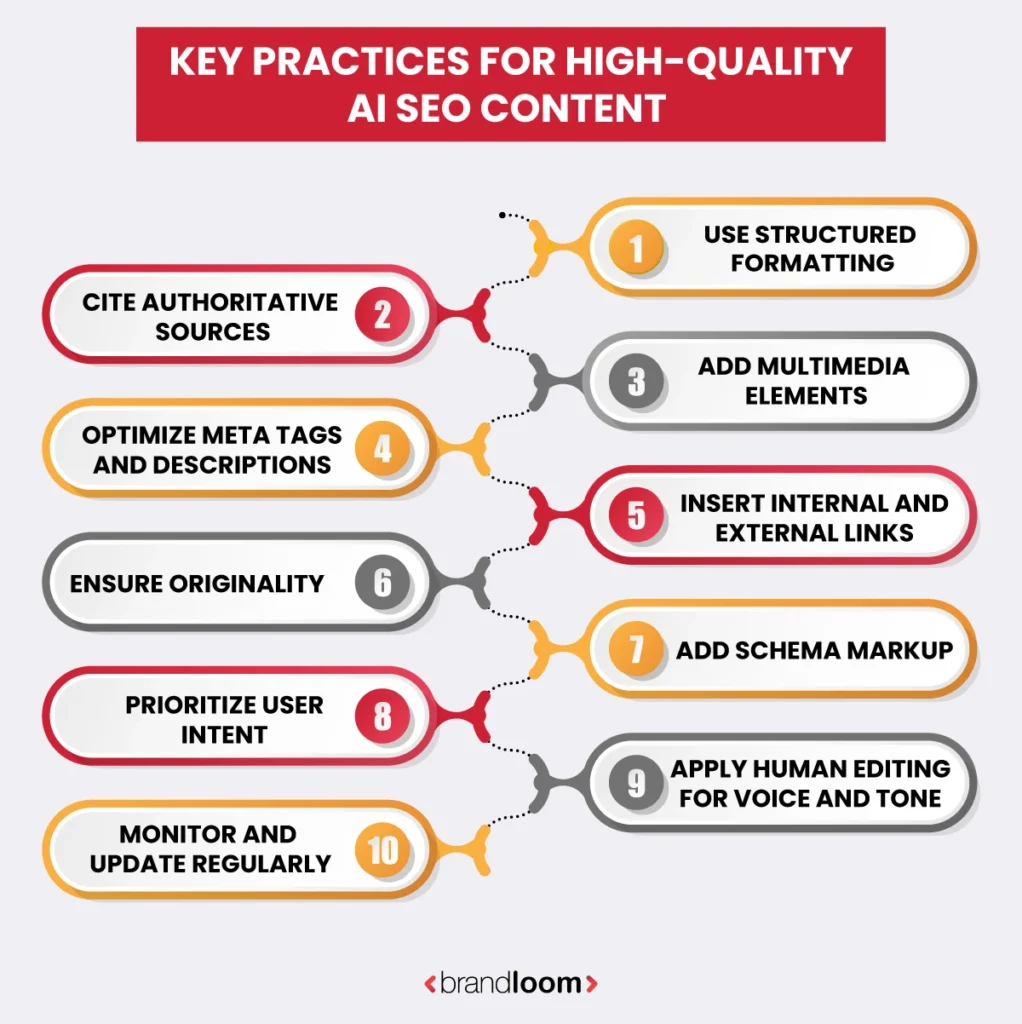
1. Use Structured Formatting
Readers and search engines both prefer clarity. Break text into short paragraphs, use H2/H3 subheadings, and apply bullet points or numbered lists. AI can generate a lot of text, but humans must ensure it’s digestible. Structured formatting boosts scannability and signals quality to Google.
2. Cite Authoritative Sources
AI may generate facts, but it often misses credible citations. Human editors should cross-check claims and add links to reputable sources—such as academic journals, government reports, or leading industry publications. This strengthens trustworthiness and shows compliance with Google’s emphasis on authority.
3. Add Multimedia Elements
AI-generated text alone rarely engages. Enhance your article with images, graphs, or infographics. For example, use a simple chart to illustrate “SEO performance before vs. after AI integration.” Multimedia improves dwell time, boosts engagement, and signals topical depth.
4. Optimize Meta Tags and Descriptions
AI can generate draft meta titles and descriptions, but humans must refine them for accuracy, keyword targeting, and click appeal. Meta elements are small, but they directly impact CTR (Click-Through Rate). Always align them with Google Search Essentials AI by making them honest, clear, and relevant.
5. Insert Internal and External Links
AI tends to overlook linking strategy. Add internal links to related blog posts and service pages, and external links to credible references. This supports SEO, builds authority, and improves navigation for users.
6. Ensure Originality
AI often paraphrases or reuses existing structures. Run every AI draft through plagiarism and originality checks. Rewrite or expand sections that feel generic. Originality is a critical AI content best practice because duplicate content risks de-indexing or ranking penalties.
7. Add Schema Markup
Structured data helps Google understand your content better. For example, you can apply Article schema or FAQ schema to improve search visibility. This often leads to enhanced snippets, higher CTR, and stronger authority signals.
8. Prioritize User Intent
Google measures how well content answers user questions. Before finalizing AI drafts, ask: Does this page satisfy search intent? Refine the content to include actionable steps, definitions, or examples that directly serve readers.
9. Apply Human Editing for Voice and Tone
AI alone cannot reflect your brand’s personality. Editors should adjust tone, refine word choice, and add anecdotes or commentary. This ensures content sounds authentic, not robotic.
10. Monitor and Update Regularly
AI-assisted blogs must not remain static. Track performance using analytics tools, identify underperforming pages, and refresh them with new insights or updated stats. Continuous improvement keeps content relevant and ranking strong.
Checklist: 10 Best Practices for AI SEO Content
- Format with clear headings and bullet points.
- Add citations to authoritative sources.
- Use images, graphs, or infographics.
- Optimize meta titles and descriptions.
- Add internal and external links.
- Check originality and avoid duplication.
- Apply schema markup for rich results.
- Write with user intent at the center.
- Humanize the voice and edit heavily.
- Refresh content based on performance data.
This checklist ensures your content stays compliant with Google Search Essentials AI while remaining engaging to readers.
Case Study: Optimizing AI Article with Schema for Higher CTR
Let’s consider an AI-generated article on “How to Use AI for SEO.”
AI Draft (Before Optimization):
- 1,200 words of text, unstructured paragraphs, no schema markup, no meta description.
- Result: The article ranks but fails to earn clicks because the snippet looks plain.
Optimized Version (After Human Editing):
- Structured headings (H2/H3), bullet points, and a clear FAQ section.
- Added FAQ schema markup so Google displays expandable questions in SERPs.
- Meta title refined to include “How to Use AI for SEO – Complete Guide 2025.”
- Meta description crafted for clarity and click appeal.
- Internal links added to related SEO service pages.
- Graph included to compare “Traditional SEO Workflow vs. AI-Assisted Workflow.”
Result: CTR increased by 28% within four weeks, proving that schema markup and structured formatting elevate even AI-assisted content.
AI can accelerate content creation, but it cannot guarantee quality or compliance alone. By following AI content best practices—from citing credible sources to adding schema—you create content that meets Google Search Essentials AI standards while engaging readers. Treat AI as a partner, not a substitute. Human editing, optimization, and compliance checks turn AI drafts into trusted, high-performing SEO assets.
Can AI Content Rank on Google?
A persistent myth says Google bans AI-written content. The reality is very different. Google has stated clearly that AI-generated content Google ranking is possible—as long as the material meets its quality standards. What Google opposes is spam, not the tool used to create the text.
If an article is unoriginal, misleading, or manipulative, it will underperform regardless of whether a human or an AI wrote it. Conversely, if AI-assisted content is helpful, accurate, and people-first, Google will rank it like any other high-value page.
This distinction is critical: Google measures value, not authorship.
Conditions for Ranking AI Content
For AI-assisted pages to appear in top search results, they must satisfy three core conditions:
- Value
Content must answer the user’s question better than existing results. AI can generate a baseline, but humans must enrich it with unique data, commentary, or perspectives. - Originality
AI sometimes paraphrases or repeats patterns. Editors must ensure that the final piece includes unique angles, examples, or fresh insights. Running originality checks and rewriting generic parts is essential. - Trust Signals
Google looks for signals of credibility. Adding author names, bios, case studies, citations, and references shows accountability. Incorporating schema markup, HTTPS, and clear site policies also enhances trustworthiness.
Together, these elements prove to Google that AI-driven content deserves visibility.
Case Study: AI vs. Human Content Performance
Let’s look at a practical comparison.
Scenario: BrandLoom created two blog posts targeting the keyword “SEO automation tools.” One was drafted primarily by AI and then lightly edited. The other was written by a human strategist from scratch, with AI only used for data gathering.
AI-First Article (Light Editing):
- Published in March 2024.
- Ranked initially on page 4 of Google.
- Bounce rate above 80%.
- Average time on page: 30 seconds.
- Feedback: Readers found it generic and “robotic.”
Human-Led Article (AI as Support):
- Published in the same month.
- Ranked in the top 5 positions within six weeks.
- Bounce rate: 43%.
- Average time on page: 2 minutes, 15 seconds.
- Feedback: Readers highlighted the examples and insights as “useful and easy to apply.”
Takeaway: AI-generated text alone rarely performs well. But when humans refine and enhance it with depth and brand voice, performance improves dramatically. This demonstrates that AI-generated content Google ranking is achievable, but only with human oversight.
How to Test AI Pages with Google Search Console
If you’re experimenting with AI content, you must track results. Google Search Console (GSC) is the best free tool for testing AI-assisted pages.
Here’s how to use it effectively:
- Submit Your AI Page for Indexing
After publishing, request indexing in GSC. This ensures Google crawls the page quickly. - Monitor Impressions and Clicks
Check whether the page is appearing in search and earning clicks. Low impressions may suggest Google doesn’t see it as helpful. - Analyze CTR (Click-Through Rate)
Compare CTR with your site average. If CTR is low, improve meta titles, descriptions, or add schema for better snippets. - Check Average Position
Track where your AI page ranks over time. If it stagnates beyond page 3, rework the content with more depth, original insights, or multimedia. - Evaluate Engagement Metrics
Pair GSC with Google Analytics to monitor bounce rate and time on page. High bounce and low dwell time often indicate thin or unhelpful content. - Iterate and Update
Use findings to refine the page. Add case studies, expert commentary, or new data. Test again after updates to see if rankings improve.
Practical Example of Testing AI Pages
Suppose you publish an AI-generated FAQ page about “AI SEO tools.” In GSC, you notice it ranks at position 30 with a 0.5% CTR. After adding:
- Author bio and credentials,
- A graph comparing AI vs. manual keyword research,
- Links to authoritative sources,
the CTR jumps to 2.1% and rankings climb to position 12. This shows how optimization, humanization, and monitoring work together to make AI content competitive.
So, can AI-generated content Google ranking be achieved? Absolutely. But AI alone won’t get you there. Google rewards originality, trust, and value. AI is best viewed as an assistant for scale and speed—not as a replacement for human expertise.
By following compliance standards, adding credibility markers, and testing performance with Google Search Console, you can create AI-assisted pages that not only rank but also engage audiences. The future belongs to hybrid workflows where AI provides efficiency, and humans provide the authenticity and insight Google values most.
Conclusion
AI has changed the way marketers approach SEO, but the fundamentals remain the same: quality and trust drive rankings. The key is to view AI as a tool, not a replacement. Businesses that treat AI as an assistant for speed and scale—and then layer on human creativity—gain the best results.
To succeed, follow three critical steps. First, align every article with AI content guidelines. Make sure your pages are helpful, accurate, and compliant with Google’s standards. Second, commit to human editing.
Even the best AI draft needs fact-checking, refinement, and personalization before it’s ready to publish. Third, keep monitoring performance. Use tools like Google Search Console to track impressions, CTR, and engagement, then optimize content where it falls short.
Looking ahead, AI content optimization will grow more sophisticated as Google updates evolve. Search algorithms will reward originality, credibility, and human insight more than ever. Businesses that blend AI efficiency with authentic storytelling will thrive, while those who rely solely on automation risk falling behind.
At BrandLoom, we help businesses strike that balance since we offer the best SEO services in India. Our team guides you through AI-driven workflows, ensures compliance with Google’s standards, and adds the human touch that builds trust with both readers and search engines.
The future of SEO is hybrid: AI plus human creativity. Adopt this approach today, and you’ll not only stay visible—you’ll build authority that lasts.
Frequently Asked Questions
You can safely use AI for SEO if you treat it as an assistant, not a replacement. The right approach is to let AI help with research, outlines, and even first drafts, while humans refine the content for accuracy, originality, and tone. Google makes it clear that what matters is quality and usefulness, not the tool you use.
Problems arise when people mass-publish thin, low-value AI content just to rank—it falls under Google’s spam policies on “scaled content abuse.” To avoid this, always check facts, provide unique insights, cite reliable sources, and make sure the piece actually solves a user’s problem. Adding schema markup, strong meta tags, and internal links also helps.
At BrandLoom, we recommend a hybrid workflow: AI for speed and data handling, humans for judgment and creativity. This way, your content aligns with Google’s expectations and earns long-term trust.
Google doesn’t maintain a special set of rules just for AI; instead, AI content has to meet the same standards as any other. In 2025, that means following Search Essentials, avoiding spammy practices, and focusing on people-first quality. Google evaluates whether your page is original, reliable, and helpful. AI content is fine—as long as it isn’t used to pump out thousands of repetitive or shallow pages.
Google specifically warns against scaled content abuse, expired domain abuse, and site reputation abuse. To stay compliant, you should review AI drafts with a human eye, make edits for clarity and accuracy, and add authorship signals like bios and references.
Transparency is also important: if your readers would expect to know that AI helped, make that clear. At BrandLoom, we build editorial checks and E-E-A-T signals into every AI-assisted content process so brands stay safe while still scaling efficiently.
Yes, AI-generated content can absolutely rank—but only if it’s useful and trustworthy. Google has repeated that it rewards quality, not authorship method. What fails to rank is generic AI text with no editing, no unique perspective, and no clear value to the reader.
What succeeds is content where AI accelerates the process, but human editors bring in expertise, storytelling, and citations. To give AI content a fair chance in search, make sure you align it with user intent, add structured data, link to authoritative sources, and clearly show who is behind the information.
At BrandLoom, we’ve seen this hybrid model outperform pure AI or pure human workflows. Clients who paired AI efficiency with expert editing not only ranked faster but also built stronger engagement with readers. So yes—AI content can rank, but the secret is how you use it.
Google’s latest AI guidance points everyone back to its existing Search Essentials, the Helpful Content framework, and updated spam policies. In simple terms, AI-generated pages are treated like any other—if they are original, helpful, and meet intent, they are fine. If they’re mass-produced and thin, they’re penalized.
Recent updates have been very clear about what Google doesn’t want: scaled content abuse (publishing massive volumes of low-value text), expired domain abuse (repurposing old sites with AI spam), and site reputation abuse (hosting poor AI content on high-authority domains). Beyond that, Google advises publishers to think “user first.”
Content should be engaging, provide answers that real people find satisfying, and demonstrate expertise or trustworthiness. At BrandLoom, we translate these guidelines into practical steps—fact-checking AI output, adding human insights, improving readability, and enriching articles with schema and visuals—so businesses can confidently use AI without risking compliance issues.
AI can help draft and structure content, but it cannot create E-E-A-T on its own. Google’s framework—Experience, Expertise, Authoritativeness, and Trustworthiness—relies heavily on signals that demonstrate human credibility. That means showing who wrote the content, highlighting their real-world experience, and providing proof through citations, case studies, and references.
AI may produce a technically correct draft, but without human input, it often lacks the depth and authenticity Google values. A strong workflow blends the two: let AI handle repetitive tasks like keyword suggestions or summarizing data, then add human commentary, unique insights, and examples.
For instance, if you’re writing about digital marketing, an AI draft could cover definitions, but your lived experience running campaigns makes the piece valuable. At BrandLoom, we emphasize humanizing AI content with bios, original research, and storytelling. That combination not only satisfies Google’s quality bar but also builds reader trust, which is the real long-term ranking factor.
The best way to use AI for SEO is to treat it as a support system, not a shortcut. Start by letting AI handle keyword clustering, outline generation, and competitor analysis. Then step in to add human depth, examples, and storytelling. Google rewards content that feels written for people, not machines.
Some key practices include: always fact-check AI output, enrich drafts with real insights, add schema markup, and optimize for clarity and flow. Don’t forget to include strong internal linking and up-to-date sources.
At BrandLoom, we follow a 3-step model: AI assists with research, human editors refine and optimize, and performance is monitored continuously. This hybrid approach ensures your content isn’t just technically correct but also engaging and credible. The result? SEO content that scales efficiently while still meeting Google’s expectations for originality, trust, and user-first value.
Ignoring Google’s AI content policies can lead to serious setbacks. If your site publishes large volumes of thin or repetitive AI text, Google may flag it as “scaled content abuse.” The consequences range from lower rankings to manual penalties and, in extreme cases, deindexing.
But the damage isn’t just algorithmic—users quickly lose trust when they encounter bland, error-filled content. That erodes brand credibility and conversions. Non-compliance also wastes resources: even if AI lets you publish quickly, content that fails to rank or engage delivers no ROI.
At BrandLoom, we’ve seen brands recover from such penalties by auditing their AI-heavy pages, rewriting them with human insights, and realigning with Google’s standards.
The lesson is clear—compliance isn’t optional. It’s the foundation for sustainable SEO. Cutting corners with AI might feel tempting, but it costs far more to fix penalties later than to build quality content upfront.
Humanizing AI content is about adding the authenticity that machines lack. Readers—and Google—want signs of lived experience, authority, and trust. Start by rewriting AI drafts with your own voice, examples, and anecdotes. Add author bios that highlight expertise, cite credible sources, and link to case studies or original research.
Storytelling also helps: instead of flat definitions, share how strategies worked in practice. Another effective tactic is using multimedia—images, charts, and videos—to make content richer. At BrandLoom, we often take an AI draft as a skeleton, then build muscle through human editing.
For example, an AI tool might list “benefits of AI SEO,” but our team turns it into a narrative with client stories, results, and stats. This hybrid approach transforms generic text into something memorable. Ultimately, humanizing AI isn’t optional—it’s what makes your content resonate with people and rank with Google.
Google’s Helpful Content Update was designed to prioritize people-first, high-value pages and demote shallow, mass-produced ones. This update matters greatly if you’re using AI. Google doesn’t care whether a person or a tool wrote the draft—it cares whether the article genuinely helps users.
If your AI output is repetitive, overly broad, or lacks original insights, it risks being flagged as “unhelpful.” The update specifically rewards content that demonstrates expertise, answers real queries, and leaves readers satisfied. At BrandLoom, we’ve noticed that AI-only blogs often struggle under this update, while AI-assisted, human-refined content thrives. The key takeaway?
Don’t publish raw AI text. Instead, refine it with expert commentary, data, and unique perspectives. This ensures you meet the spirit of the Helpful Content Update and position your site for long-term SEO success. AI is fine—but helpfulness is non-negotiable.
Optimizing AI content starts with aligning it to Google Search Essentials. That means every page must be helpful, original, and easy to crawl. When using AI, first check that the draft answers user intent clearly.
Then edit for accuracy, add examples, and cite credible sources. Google also values structure, so use headings, bullet points, and schema markup to help search engines understand your content.
Don’t skip technical SEO basics: optimize titles, meta descriptions, and internal links. At BrandLoom, we treat AI drafts as a raw resource and polish them into well-structured, user-first articles that meet Search Essentials.
This hybrid approach allows you to scale without sacrificing quality. Remember—Google doesn’t rank content because it’s AI-free, it ranks it because it is trustworthy and useful.
If you rely on AI to mass-produce shallow, repetitive, or misleading pages, Google can penalize your site in several ways. The most common outcome is ranking loss—your pages simply stop showing up on page one.
In more serious cases, Google may apply manual actions that require fixes before your site can recover visibility. Extreme violations, like using AI to spam expired domains, can even lead to deindexing. Beyond technical penalties, your reputation also takes a hit when users abandon low-quality pages.
At BrandLoom, we’ve helped brands recover by auditing AI-heavy sites, rewriting thin pages, and improving signals of trust such as author bios and citations. Avoiding penalties isn’t complicated—it’s about editing AI content with a human eye and ensuring it provides genuine value.
The biggest mistake is publishing AI output “as is.” Raw AI text often sounds generic, lacks depth, and may contain errors. Another common issue is overproduction—flooding your site with dozens of thin pages that compete with each other and confuse Google.
Skipping fact-checking and failing to cite sources also hurt credibility. Finally, ignoring tone makes content feel robotic and untrustworthy. To avoid these pitfalls, always edit drafts, add unique insights, and refine the flow. At BrandLoom, we follow a checklist: check facts, enrich with examples, match tone to audience, and optimize SEO signals.
This process transforms an average AI draft into content that ranks and resonates. Mistakes happen when brands chase speed over quality—but with the right balance, AI can save time without compromising standards.
Google’s AI policies and Helpful Content framework are closely linked. Both stress the same point: content should serve people first, not search engines. The Helpful Content system is designed to identify and devalue content that is shallow, repetitive, or created purely to manipulate rankings.
If you publish unedited AI output, you risk being hit by both AI-related spam policies and the Helpful Content filter. On the other hand, if you use AI responsibly—supporting human experts with research and drafts—you can scale content while staying compliant. At BrandLoom, we align every AI-assisted workflow with the Helpful Content approach.
That means focusing on real user needs, adding credible voices, and ensuring every page leaves readers satisfied. When AI and Helpful Content guidelines work together, the result is sustainable rankings and stronger audience trust.
Trust comes from showing your audience that real people stand behind the information. If you publish only AI-generated articles, readers may sense the lack of authenticity and disengage. To build trust, add author names, bios, and credentials.
Support claims with data, credible sources, and case studies. Transparency also matters—let readers know when AI supported the process, while highlighting the human expertise that refined it. At BrandLoom, we believe in humanizing AI content with unique perspectives and clear accountability.
By combining machine efficiency with human insight, you maintain both speed and credibility. Google also looks for trust signals when ranking pages, so reinforcing authority benefits SEO as much as it benefits readers. In short, AI can support trust-building, but it cannot replace it.
The future of AI in SEO looks promising but requires caution. As AI tools get more advanced, they will handle more of the heavy lifting—keyword clustering, performance analysis, and even first drafts.
But human oversight will remain essential for originality, empathy, and trust. Google is also investing in AI-powered search experiences like Search Generative Experience (SGE), which makes quality even more important. Content that blends AI efficiency with human storytelling will stand out.
At BrandLoom, we see the next phase as a “co-pilot” era: AI accelerates production, humans guide quality. Brands that master this balance will scale faster while staying compliant with Google standards. The future isn’t about replacing people with AI—it’s about combining both strengths to deliver better results, stronger rankings, and richer user experiences.

